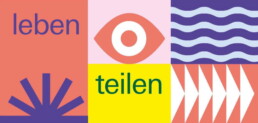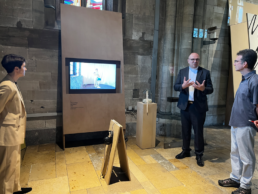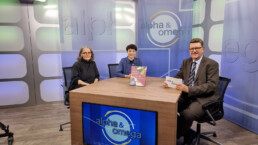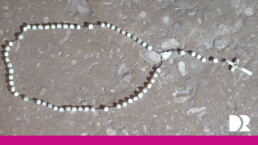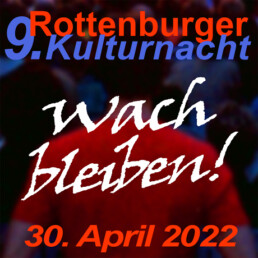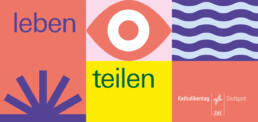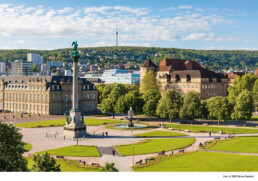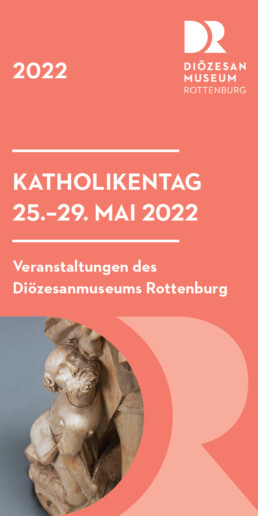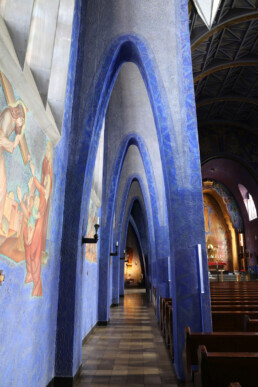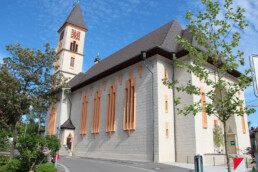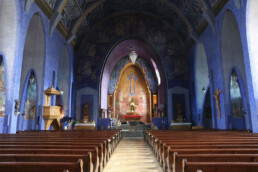We make art strong in times of crisis
At the Katholikentag in Stuttgart, award-winning works from the art competition "Vulnerable" will be on display for the first time in St. Maria's from 27 May.
The competition had met with a great response: Around 600 artists applied, 25 young creatives were selected. They dealt with the vulnerability of human life in a variety of ways.
“The pandemic and most recently the war in Ukraine have brutally torn us out of what we take for granted in life,” says Auxiliary Bishop Dr Gerhard Schneider, who is also responsible for art in the Diocese of Rottenburg-Stuttgart. “It is difficult to put this much-cited ‘turn of time’ into words. For us as a church, it is important to make art strong, especially in times of crisis like these. Art offers ways to express, find and orient oneself in the unknown and always incomprehensible events of our time – especially where words are no longer able to do so.”
Achieving two kilometres of distance with one step
The works are correspondingly diverse in their form of presentation. For example, Simon Pfeffel’s video performance “Mit einem Schritt” (With one step), which won him one of the first prizes, shows how he covered the approximately two-kilometre distance from Stuttgart’s main railway station to St. Mary’s with just one step. “To do this, the artist tied one of his legs up and then hopped and limped his way through Königsstraße,” reports Sebastian Schmid, theologian and curator of St. Maria’s, who was part of the interdisciplinary competition jury along with nine other people.
Schmid: “Simon Pfeffel was clear that he would not make it without the help of strangers. Nevertheless, he didn’t ask anyone for help. Only when passers-by in Stuttgart offered to support him did he let themselves be carried or propped up. The exhibition shows video recordings of this impressive action, in which he put himself at the mercy of strangers.”
The motto of the Katholikentag also stands for being vulnerable together
The director of the Diocesan Museum in Rottenburg, Dr Melanie Prange, who was responsible for the competition and also a member of the jury, is pleased that the exhibition will now be opened during the Katholikentag. “Our works of art fit particularly well with the motto ‘sharing life’ of the Katholikentag, because all people are vulnerable, because vulnerability is precisely the essential moment of human existence and God has exposed himself to this vulnerability. Together we are vulnerable and it is especially in togetherness that paths to healing are paved. The motto of the Katholikentag brings essential thoughts of our competition and exhibition theme once again to the point.”
Kriz Olbricht wants to show with his artwork that the church itself is also vulnerable. To do this, he has hammered five dividing wedges into the wall of St. Maria. These are a kind of nails that normally create cracks in stones.
“It took a lot of convincing before the artist was allowed to hammer these dividing wedges into the wall of the church,” Schmid reports. “Just the idea that there could be a crack in the church wall almost caused panic in some people. The congregation itself was the least afraid.” The parish council immediately understood what Olbricht was about, he says. “After all, the five nails in the chancel stand for questions like: How seriously does the church take the cross? Does it dare to make itself vulnerable? Does it risk its own structure to take the side of the wounded?”, the theologian explains further.
Exhibition on view in Stuttgart from 27 May to 24 July
Visitors to the exhibition can look forward to nine more works of art, which will be on display in St. Mary’s from 27 May to 24 July. Dr. Prange is pleased that the exhibited works inspire new perspectives: “”The diocese has consciously decided to formulate a question and to let itself be challenged by the answers of young creative people – in other words, to make itself vulnerable and open. Especially against the background that the church itself is responsible for the worst psychological and physical wounds. Taking creatives seriously and not giving them guidelines enables a serious engagement with religious content, biblical texts and existential questions. The artistic results are surprising, inspiring, open to interpretation and testify to the depth of the engagement. A result to be emphasised for the cooperation and interaction of church and art.”
Award ceremony at the vernissage on 27 May.
The award ceremony of the Vulnerable competition will take place at the vernissage of the exhibition on Friday, 27 May, at 7.30 pm with Bishop Dr Gebhard Fürst and the members of the jury in St Mary’s. Some of the artworks will also be exhibited there until Sunday, 24 July.
In addition, there will be a tandem exhibition at the Diözesanmuseum Rottenburg between 19 June and 28 August with the other part of the award-winning works. The vernissage of this exhibition with Auxiliary Bishop Dr Gerhard Schneider will begin on Sunday, 19 June, at 3 pm.
You can find further information online: https://dioezesanmuseum-rottenburg.de/vulnerable-preistraegerinnen/
More than timpani and trumpets
Press release
Stuttgart, 27 April 2022
Concerts, cinema, dance, art and literature, exhibitions, cabaret and theatre – more than 200 cultural events invite you to experience and marvel at the Katholikentag in Stuttgart. The organisers presented this wealth today at the Haus der Geschichte in Stuttgart. “With our cultural programme, we want to transport the atmosphere of the Katholikentag into the city for five days,” emphasised Paul Magino, chairman of the Katholikentag’s cultural working group. More than 100 bands, choirs and individual artists have been selected in an application process and will be responsible for a large part of the cultural programme.
And: “We are working together with many cultural institutions in the city of Stuttgart, such as the Linden Museum, the State University of Music and Performing Arts, the House of Music, the State Gallery and the Old Playhouse, and will significantly enrich the Stuttgart cultural scene for this time of the Katholikentag.” Some venues at the Katholikentag are firmly linked to a particular genre: for example, cabaret lovers will flock to the Renitenztheater and the Gustav-Siegle-Haus. Those interested in author readings should note the Wanner Hall in the Linden Museum with readings by Anna-Katharina Hahn, Nora Bossong and Josef Haslinger.
Exhibitions provide their very own insights, such as “Under the Skin – My Tattoo, My Story” in the Akademiegarten (open-air). The most extensive and highly topical project of the Diözesanmuseum is the exhibition “”Vulnerable – Verletzlich” (Vulnerable – Vulnerable) in St. Maria, in which the award-winning works of the art competition of the same name of the Diocese of Rottenburg-Stuttgart – in selection – are presented. The background: The Corona pandemic and, most recently, the warlike actions in Ukraine made us clearly aware of our vulnerability. Vulnerability is an essential moment of human existence that weakens, but can also strengthen. In setting the task, the diocese had consciously decided to formulate the question of vulnerability openly and to allow itself to be challenged by the answers of young creative people – in other words, to make itself vulnerable and open. Especially against the background that the church is responsible for the worst psychological and physical wounds to children, young people and queer people, as recent studies and revelations have made shockingly clear. Around 600 artists responded to the call for entries. Contemporary art forms such as installations, video and sound works, projections and performances as well as objects of the classical visual arts such as paintings, drawings and sculptures were submitted.
The most extensive segment of the cultural programme at the Katholikentag is music – and this will be heard in very different places in the city. Gospel concerts, pop and rock, new spiritual songs, organ music and contemporary orchestral works will offer listening pleasure. A special work that also invites participation is the #coronation mass. At the centre of the premiere is Mozart’s Coronation Mass KV 317 as a symbol of joie de vivre and confidence. In addition, the specially developed sound installation allows each individual visitor to become part of the whole in advance – with the help of his or her individual voicemessage sung on the short musical phrase “Dona nobis pacem” using a smartphone. Simply sing it, call +49 711 20 70 31 70 and sing it on your voicemail or record it as a voice memo and send it by message to coronation@katholikentag.de. The deadline for sending in voice messages is 10 May.
The extensive film programme of the Katholikentag with its discussions is not only aimed at interested cineastes, but also at pupils and students and addresses current socially relevant questions. For example, in the film with discussion “The Unknown Girl”, which deals with moral integrity and social justice.
Contact:
Stephan von Kolson, phone: +49 175 4343485, email: presse@katholikentag.de
Shaping faith, fashioning splendour
How theological content is conveyed through fabrics and clothing is the subject of this issue of "Alpha and Omega".
Clothes make the man – and sometimes also tell us something about people’s faith. This is the subject of a large fashion exhibition in the Diocesan Museum in Rottenburg am Neckar – and in the next issue of “Alpha & Omega – Church in conversation”.
Magnificent vestments of saints can be admired in many pictures. Museum director Melanie Prange reports on how theological content is conveyed through these fabrics and how textiles make the sacred tangible, so to speak.
In cooperation with the Pforzheim University of Applied Sciences, fashion students also designed their own collections and liturgical vestments of the future for the exhibition. It becomes clear that religion and fashion have a lot in common, as Pforzheim professor Sybille Klose explains in the programme.
Watch the programme
The programme “Shaping Faith – Fashioning Splendour” produced by KiP-TV was first broadcast on 30 April 2022. You can find this and other episodes of “Alpha and Omega” on the YouTube Diocesan Museum Channel.
Talking about sacred art and textile messages: Prof. Sybille Klose from the Pforzheim Faculty of Design, Dr Melanie Prange, director of the Rottenburg Diocesan Museum, and presenter Christian Turrey.
Picture: KiP-TV
In the name of the rose - until death
Excavations have uncovered graves from the 17th/18th century. Also contained therein: Rosaries. Matthias Raidt explains these finds in his own and very interesting way.
The video is part of the series Treasures from the Sülchen Church.
12.04.2022
Cooperation with the University of Church Music
Meaningful
From 11 April, the glass and iron sculpture “Meaningful” by Susanne Röwer will be on display in the newly designed foyer of the Rottenburg College of Church Music. The art object, created in 2021, was acquired by the Diözesanmuseum for the new field of activity “Contemporary Art and Art Education”. This field is dedicated to artists of the present day, mediating their works and bringing them into dialogue with the Christian iconography of past art epochs. In future, the university will regularly present such modern museum pieces and thus create a meeting place in its rooms for the visual arts as well.
Röwer’s sculpture is being shown for the first time in Rottenburg. The artist, who works with very different genres such as metal, glass, stone or paper and exhibits internationally, combines the materials in an impressive way. The Rottenburg art object, a foreign body in the minimalist foyer, also gives the visitor pause. Almost organically, it seems to float above a flat base, to rise, to creep. Iron coils with pointed thorns form a ring above three groping feelers; inside, a reddish bubble of glass. The thorns cut deeply into the translucent surface, as if it might burst at any moment. At the same time, the bubble adapts to the thorns, partially encloses them, seems to waft and pulsate.
The first association that comes to the viewer’s mind is probably the crown of thorns. Symbol of supreme suffering, of Christ’s mockery, but also a distinction and symbol of his kingship, his omnipotence. In Latin, the crown is called “corona”, a term omnipresent today with a completely different meaning. Corona, too, has become a symbol of suffering for many people, but still allows many people to rise above themselves, distinguishes them. In the sculpture, symbols and perspectives combine; iron and glass, hardness and fragility, both formed in fire, meet in lively interplay. The sculpture is thought-provoking and opens up meaning for the visitor, in Holy Week and beyond.
Please register with the secretary’s office (Tel.: +49 7472 169820) to view the sculpture.

9. Rottenburger Kulturnacht
Wach bleiben!
Melden Sie sich direkt an:
Das Diözesanmuseum gestaltet den Katholikentag mit
Katholikentag 2022 in Stuttgart
Das Diözesanmuseum gestaltet mehrere Kulturveranstaltungen auf dem Katholikentag mit. Es lohnt sich also um so mehr, Ende Mai nach Stuttgart zu kommen. Der Eintritt zu den Veranstaltungen ist über die Tickets zum Katholikentag möglich.
Veranstaltungen des Diözesanmuseums auf dem Katholikentag
Mariä Himmelfahrt: Durch tiefblaue Sphären in lichtgoldene Höhen
Die 1927 geweihte Kirche Mariä Himmelfahrt in Baienfurt bei Weingarten stellt als expressionistischer Sakralbau an sich bereits eine Besonderheit dar: Inmitten der barocken Kirchenlandschaft Oberschwabens gelegen, mutet sie geradezu exotisch an. Während der Außenbau sich zurückhaltend gibt, taucht der fremde Besucher, sobald er das Kirchenschiff betritt, in eine ungewöhnliche und überwältigende Welt ein. Es herrscht ringsum ein dunkles nuancenreiches Blau, das zudem je nach Lichteinfall und Tageszeit ihn als Ultramarinblau, Blaugrün oder Blauviolett umhüllt und verzaubert. Und so bezeichnet die einheimische Bevölkerung ihre Pfarrkirche auch stolz als „unsere blaue Grotte“.
Grundriss
Der Grundriss zeigt einen in Westostrichtung angelegten rechteckigen dreischiffigen Längsbau, ein lediglich angedeutetes Querschiff und einen leicht vorspringenden Vorbau im Westen. Der schmale eingezogene Chor mit quadratischer Grundfläche im Osten wird seitlich von Baukörpern mit ebenfalls quadratischer jedoch kleinerer Grundfläche gerahmt: Im Norden der Turm und im Süden die Sakristei.
Außenbau
An dem gestaffelt gegliederten Baukörper mit hoher ebenfalls abgestufter dreiseitiger Walmbedachung fällt zunächst die Westfassade mit ihrer monumentalen in Parabelform überwölbten Nische auf. Die Fenster betonen mit ihrer extremen Schmalheit die Vertikale. An der Nord- und Südfassade sind sie zu gestaffelten Dreiergruppen zusammengefügt. Die in rötlichem Ocker gefasste Rahmung aller Fenster mit ihren überlängten Laibungen und Stürzen kontrastieren zum hellen Rauhputz und dessen horizontalen Ritzfugen.
Innenraum
Dem schmalen Eingangsraum und dessen Nebenräumen, über die sich die Empore erstreckt, folgt der breite und hohe Gemeinderaum. Jeweils fünf Parabelbögen ruhen auf gestreckten Konsolen und verbinden das Hauptschiff mit den Seitenschiffen. Diese sind so schmal, dass sie lediglich Umgangscharakter haben. Das Gewölbe des Hauptschiffes erinnert an spätgotische Netzgewölbe: Es gliedert sich in seiner Längsachse in vierzehn gefaltete und mit Stabwerk besetzte Flächenbahnen, die von den Gurtbogengesimsen rhythmisch in Teilstücke getrennt sind.
Den um sieben Stufen erhöhten Chorraum trennt wiederum ein parabelförmiger Triumphbogen vom Gemeinderaum. Dieser Bogen wiederholt sich in mehrfacher Abstufung an der Chorabschlusswand, einen Baldachin assoziierend.
Innenraum bestimmende Momente sind Farbgebung und Lichtführung. Im Chorraum fällt, für die Besucher nicht sichtbar, Licht durch die südlichen Chorwandfenster ein.
Die farbliche Gestaltung der Wandflächen ist in doppelter Hinsicht alles andere als eintönig: Die blaue Farbe hellt sich in den Seitennischen, an der Empore und im Bereich der Seitenaltäre zu Grau auf und geht im Chor zu Blau-Violett über. Und der Farbauftrag ist nicht gleichmäßig, sondern mit andersfarbigen Winkelformen bewusst fleckig und diffus gestaltet.
Liturgie und Raum: Zur Ausstattung
Die farbige Wandgestaltung in Blautönen, das Fresko der Chorabschlusswand, die Kreuzwegdarstellungen sowie die Entwürfe für die Glasfenster schuf der Maler Alois Schenk. Blau verweist auf Maria, die Titelheilige der Kirche. Das Gemälde über dem Hauptaltar ist eine Bildsynthese von Mariä Himmelfahrt und Marienkrönung: Hier lichtet sich das ferne Blau, Maria wird von goldgelben Sphären umflutet.
Sowohl die architektonische Formgestaltung mit der Betonung der breiten, die Gläubigen zur Gänze aufnehmenden, und auf den Hochaltar von 1927 ausgerichteten Längsachse als auch das die Ostwand füllende monumentale Gemälde sind Ausdruck damaliger Frömmigkeit und eines gewandelten Gemeindeverständnisses: Die Kirche solle sowohl als Gemeinschaft als auch als Bauwerk ganz auf Christus den König bzw. im Falle der Marienkirchen auf Maria als Königin konzentriert sein.
Die 1999 vom Künstler Joachim Sauter eingefügte Altarinsel mit Ambo und Zelebrationsaltar greift diesen Gedanken auf. Der Altar wurde in Anlehnung an die kristallinen Lampenformen und an das intensive Blau der umgebenden Wände aus dunkelblauem Quarzit gestaltet.
Der Kreuzweg, den Alois Schenk zur Gänze erst 1934 vollenden konnte, zeigt kantige und herbe Gestalten mit gebrochenen und verzerrten Formen. Die rahmenlose Wandmalerei an den Seitenschiffwänden sprengt den Raum.
Architekt
Der Architekt A. Otto Linder (1891-1976) schuf nach dem Ersten Weltkrieg insbesondere im Bistum Rottenburg-Stuttgart Kirchen, die ein neues Liturgieverständnis verkörpern sollten: Im Gemeinderaum rückte er die Stützen nach außen und setzte den erhöhten Chor deutlich davon ab, damit Altar und Kanzel von allen gut eingesehen werden konnten. Nachdem Linder erste Erfahrungen im Kirchenbau unter anderem in Gosbach und Mühlacker gesammelt hatte, konnte er diesen Ansatz in Baienfurt erstmals konsequent umsetzen. Das hier prägende Motiv der Parabel findet sich in seinem Werk z. B. auch bei der Heilig-Kreuz-Kirche (1927) in Kuchen bei Geislingen, bei Mariä Himmelfahrt (1929) in Klein-Süßen bei Göppingen und bei der Taborkirche (1931) in Freudenstadt.
Kirchenmaler
Dem Maler Alois Schenk (1888–1949) hatte das Handwerk der Dekorationsmalerei erlernt, daneben besuchte er Abendkurse an der Stuttgarter Kunstakademie. Seine dortigen Lehrer Christoph Landenberger, Adolf Hölzl und Friedrich von Keller waren allesamt Vertreter des Expressionismus. Besonders herausragend ist sein Kreuzweg in Röhlingen von 1919–1922.
Fazit
Die ausdrucksvolle Architektur mit ihrer Lichtführung und die malerische Gestaltung machen die Kirche einzigartig. Architektur, Malerei und Ausstattung sind bis ins Detail aufeinander abgestimmt und steigern sich gegenseitig in ihrer expressionistischen Wirkung zu einem Gesamtkunstwerk.
Dr. Iris Dostal-Melchinger
12.10.2021
Chapel Talks
Eckhard Raabe’s chapel talk with Dr Melanie Prange is about the many new online offerings of the Diocesan Museum that were created during the Corona period, as well as the current exhibitions that are now accessible again.
The importance of sacred art in general also comes up – especially with regard to the question of how contemporary art can be integrated into historic church spaces.
Photo: Sara Opic, “The Listener”, figure made of clay and straw, installation on the occasion of the 500th anniversary of the church of St. Martin in Leutkirch im Allgäu in 2019, (Photos: Heiko Grandel, Augsburg) / http://www.saraopic.com/.
"Ante saecula" - Liturgical music from the early Middle Ages
On the occasion of the finissage of the exhibition “In our Soil. Grave finds of the Early Middle Ages in the Southwest“, the Schola Cantorum at the Institute of Musicology at the University of Tübingen, under the direction of Prof. Dr. Stefan Morent, will present a short programme in a livestream, which was originally intended as a musical accompaniment to the opening of the exhibition.
Although no direct written musical tradition has survived from the time of the excavation finds from the early Middle Ages, the process of incipient Christianisation quickly led to the establishment of religious centres in the German southwest as well, such as the island monastery of Reichenau in Lake Constance or the monastery of St. Gall. These monasteries also provided some of the earliest musical sources for liturgical chant, the so-called Gregorian chant, which shaped and structured both the celebration of Mass and the Liturgy of the Hours.
The contact surfaces between pagan traditions and Christianisation are reflected in the “Song of George”, which in Old High German shows the model of the heroic epic, but reworks it in Christian terms. It probably did not originate on the Reichenau, but corresponds with the veneration of the saint there.
Finally, the Christmas sequence by Notker Balbulus, the “Stammler”, who worked there as an eloquent poet-musician in the later 9th century, leads to St. Gall.
Artists
Schola Cantorum
at the Musicological Institute of the University of Tübingen
Conductor: Prof. Dr. Stefan Morent
Singers: Michael Braunger, Alexander Goossenns, Stefan Morent, Samuel Schick, Tilo Schmid-Sehl, Janis Tortora

Programme
- Introitus Statuit ei dominus
- Kyrie in summis
- Georgslied
- Alleluia Dies sanctificatus
- Notker Balbulus (840–912): Sequence Natus ante saecula
(all transcriptions and arrangements from the medieval manuscripts by Stefan Morent).
Registration is not required.
You can watch a recording of the online finissage here directly on our site or on the Youtube channel of the diocesan museum Rottenburg.
